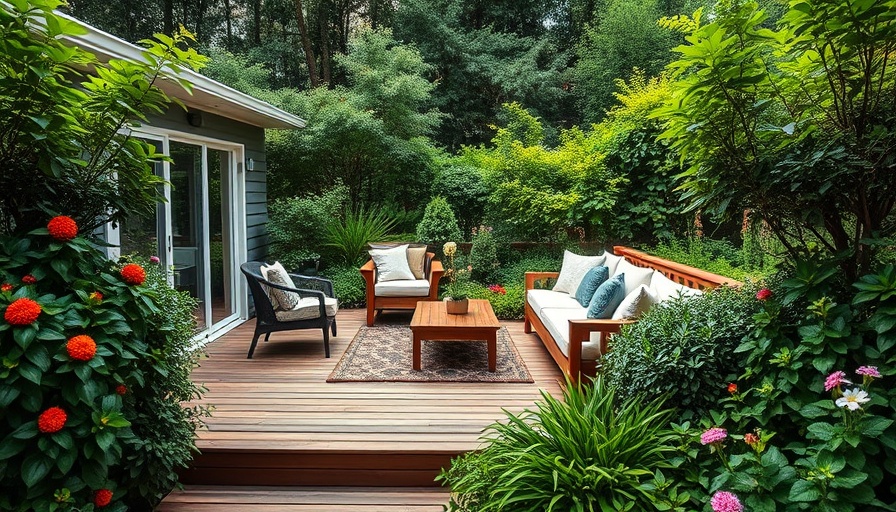
Create an Outdoor Oasis: Transforming Small Spaces
With the hustle and bustle of daily life, many of us find it challenging to dedicate time to landscape our outdoor spaces. However, a small backyard can truly spring to life with a little creativity and thoughtful design. Recently, a homeowner named Jack shared his vision for his underutilized backyard—a transformation that would provide a cozy haven for his family. By focusing on functionality and style, this rejuvenation highlights the beautiful potential of small outdoor areas.
In 'Small Backyard Transformed Into A Beautiful Outdoor Space | Great Home Ideas', the discussion dives into innovative ideas for small gardens, exploring key insights that sparked deeper analysis on our end.
From Lawn to Deck: The Power of Modular Living
Jack's journey began with the decision to remove his difficult-to-maintain lawn. He noted that shady spots made it nearly impossible to enjoy a traditional turf area. His alternative? A sturdy deck crafted from beautiful spotted gum timber. The modular design includes three landings, providing ample space for family gatherings and leisure activities. This type of structure not only enhances usability but also adds aesthetic value to the space, inviting family members outdoors to enjoy the fresh air.
Contemporary Color Palette: Brightening Up with White
One of the most striking features of Jack's backyard renovation was the bold decision to paint the existing brick wall white. This choice created a clean, bright backdrop that immediately draws the eye. To soften the starkness of the wall, rusty decorative screens were added—an affordable yet effective way to enhance privacy and visual appeal. This color palette transitions beautifully as plants are added, seamlessly blending nature's hues with structured designs.
Plant Selection: Fostering A Beautiful and Functional Garden
When choosing plants, Jack focused on varieties that require minimal maintenance yet deliver stunning visual contrast. The installation features Pittosporum ‘Hole in One’ for their neat ball shape, alongside contrasting Raphiolepis ‘Oriental Pearl’ and vibrant grasses. He admired his neighbor's successful Magnolia ‘Teddy Bear’ and decided to incorporate it into his design. The plant not only flourishes but also provides an appealing fragrance, thereby enhancing the overall sensory experience of the garden.
Practical Tips for Creating Your Own Outdoor Retreat
Those inspired by Jack's transformation can employ these practical gardening techniques:
- Container Gardening: Great for small spaces, container gardening allows you to grow a variety of plants and vegetables without requiring much soil space.
- Mulching: Protect your plants with a layer of mulch, which retains moisture, prevents weeds, and improves soil health.
- Raised Garden Beds: Ideal for those with limited mobility or imposing soil conditions, raised beds can increase accessibility and improve drainage.
- Effective Watering Schedule: Newly planted gardens benefit from regular moisture, preferably when the sun isn't blazing to reduce water loss through evaporation.
- Sustainable Gardening: Consider organic methods for pest control by introducing beneficial insects and avoiding harsh chemicals in your garden.
Unleashing Your Creativity: Personalization in Landscaping
Jack's backyard remodel serves as a vibrant reminder that with the right approach, anyone can cultivate a unique outdoor space that reflects their personal style and needs. As Jack remarked, the best part of the renovation was seeing how it could be actively enjoyed. Life in the garden is about more than just aesthetics—it's about creating a serene space for family and friends to connect and relax. Designing smaller, manageable outdoor areas fosters a more intimate experience that can be cherished for years to come.
Take the First Step in Your Garden Journey
Whether you're inspired by Jack's transformation or eager to redesign your own backyard, the path to creating an inviting outdoor space is filled with possibilities. Begin by envisioning what kind of retreat you want to enjoy and take small steps towards bringing that idea to life. From planting diverse flowers to establishing a vegetable garden, every choice contributes to a personalized oasis at home.
 Add Row
Add Row  Add
Add 




Write A Comment